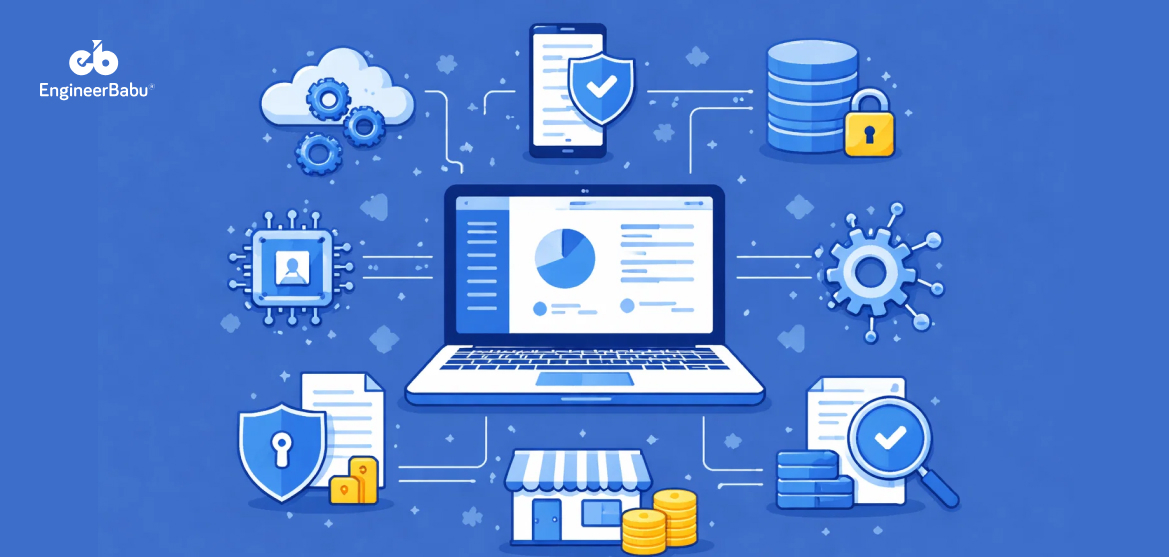Fintech apps are meant to make financial life easier with features like swift payments, seamless onboarding, and smart wallets. But anytime convenience leaps ahead, fraud follows closely behind.
For instance, in 2024, as per the Federal Trade Commission, consumers in the U.S. lost more than $12.5 billion to fraud, a sharp 25% increase over the prior year. That surge isn’t limited to the U.S.
Globally, the digital payment fraud market is projected to hit a staggering US$19,997.9 Mn by 2032, as stated by Persistence Market Research.
When the financial stakes are this high, engineers and product leaders can’t treat fraud prevention as an afterthought. It has to be engineered in from day one. That is why, in this article, we’ll explore real, actionable and best practices to prevent fraud in fintech apps.
You’ll walk away knowing exactly how to raise the bar on security for your users and protection for your bottom line.
Understanding the Types of Fraud in Fintech
Fraud in fintech is rarely a single type of threat. It comes in many forms, each exploiting gaps in identity verification, transaction monitoring, or user behaviour.
In order to use the best practices to prevent fraud in fintech apps, it’s important to first understand the most common types of fintech fraud.
Identity Theft and Account Takeover
One of the most frequent attacks involves stolen personal information. Criminals use leaked data, such as social security numbers or bank details, to open new accounts or hijack existing ones. Once inside, they can drain balances, apply for credit, or launder money through seemingly legitimate accounts.
Phishing and Social Engineering
No matter how secure the code, fraudsters often target users directly, making cybersecurity in fintech a constant concern. Phishing emails, fake SMS alerts, or cloned login pages are used to trick people into revealing passwords and OTPs. Moreover, social engineering tactics are becoming increasingly sophisticated, making user education just as critical as technical safeguards.
Payment and Transaction Fraud
In-app transactions are prime targets. Fraudsters may use stolen card details for unauthorised purchases, set up synthetic identities to test stolen credentials, or exploit loopholes in payment gateways. Without real-time detection, even small-scale attacks can accumulate into significant losses.
Money Laundering and Regulatory Exploits
Fintech apps often handle rapid transfers across borders. That speed can be misused to mask illicit activity. Criminals may break large sums into smaller amounts (a tactic known as smurfing) to avoid detection or exploit weak compliance checks in emerging markets.
Emerging Threats
Newer fraud patterns are rising as fintech evolves. For example, deepfake technology has been used to bypass biometric checks, and fake lending apps lure users with promises of instant credit before stealing sensitive data. The industry is constantly adapting to stay ahead of these tactics.
Understanding these categories is the foundation for performing the best practices to prevent fraud in fintech apps. Once leaders know how fraudsters operate, they can prioritise the right protections before scaling.
Importance of Fraud Prevention in Fintech
Fraud prevention goes beyond protecting finances. It protects customer trust, preserves brand reputation, and supports long-term growth. When a fintech app falls short on security, the damage reaches far beyond a single compromised transaction.
Financial Losses That Compound Quickly
Fraud-related losses can escalate rapidly, draining resources that could otherwise fuel growth and innovation. For smaller fintech startups, even a single large-scale incident can threaten survival.
Beyond direct theft, reimbursement to customers and partners increases the financial burden. Following the best practices to prevent fraud in fintech apps helps minimise these risks early.
Regulatory and Legal Penalties
Compliance is non-negotiable in financial services. Fraud incidents can trigger audits, fines, and even restrictions from regulatory authorities. A weak security framework may cost a company its license to operate in specific markets.
Therefore, building fraud prevention into the core app design keeps businesses aligned with regulations and prepared for growth.
Customer Retention and Loyalty
Fintech security mistakes directly impact user loyalty. Customers are far more likely to continue using a fintech app if they feel their money and data are safe. Quick responses to suspicious activity strengthen trust between the company and its users.
Also, long-term retention improves when fraud prevention becomes part of the overall customer experience.
Damage to Brand Reputation
Trust is the currency of fintech. When users lose confidence in an app’s ability to protect their data, they quickly switch to competitors. Negative publicity can linger. Thus, making customer acquisition and retention far more difficult.
By applying the best practices to prevent fraud in fintech apps, companies safeguard not only transactions but also their reputation.
Long-Term Scalability
Investors and partners assess security readiness before committing to fintech collaborations. A strong fraud prevention strategy reassures stakeholders that the platform is resilient and scalable.
It also allows companies to expand confidently into new markets without fear of unchecked risks. Preventing fraud is not just an operational need but a growth enabler.
7 Best Practices to Prevent Fraud in Fintech Apps
Before diving into specific measures, it’s worth noting that fraud prevention is never a single solution. It requires a layered approach that combines technology, compliance, and user awareness.
The following best practices to prevent fraud in fintech apps highlight the strategies that consistently prove effective for companies serious about protecting both customers and business growth.
Strong User Authentication and Verification
Authentication is the first barrier between attackers and customer accounts. Multi-factor authentication combined with biometrics significantly reduces the chances of unauthorised access.
Fintech apps that layer KYC and AML checks at onboarding make it harder for criminals to slip through with stolen identities. As a result, this proactive approach strengthens security without disrupting user experience.
Secure Data Encryption and Storage
Customer data is the core asset in any fintech ecosystem, and protecting it requires end-to-end encryption. Sensitive details such as card numbers and passwords should never be stored in plain text.
Tokenisation of payment data and secure API integrations further limit the damage in case of breaches. Strong encryption policies assure users that their financial details remain safe.
Real-Time Fraud Detection with AI and ML
Static rules no longer stop sophisticated attacks. Modern fintech companies leverage machine learning models to track anomalies across thousands of transactions in seconds.
By integrating AI and ML in fintech, companies are spotting unusual spending patterns or location mismatches that systems can halt fraud before losses mount. Real-time monitoring ensures the platform adapts to evolving threats rather than staying reactive.
Regular Security Audits and Penetration Testing
Security systems are only as good as the last time they were tested. Continuous vulnerability assessments help uncover weaknesses before criminals exploit them. Also, independent penetration and security testing add a fresh perspective and validate the effectiveness of internal defences.
Therefore, this consistent evaluation process builds a stronger, more resilient fintech infrastructure that evolves with new risks.
Transaction Limits and Risk-Based Authentication
Fraudsters often push boundaries by testing stolen cards or exploiting loopholes with small but repeated transactions. So, setting transaction limits for new accounts helps control exposure during high-risk periods.
Risk-based authentication adds another layer, requiring stricter checks when suspicious behavior appears. These best practices to prevent fraud in fintech apps strike a balance between smooth user journeys and secure operations.
User Education and Awareness
Technology alone cannot defeat fraud, informed customers are equally important. Simple reminders about phishing attempts or weak passwords can stop many attacks before they happen.
In-app alerts and awareness campaigns build user confidence while reducing overall vulnerability. An educated customer base becomes an active line of defence for the fintech platform.
Regulatory Compliance and Legal Safeguards
Lastly, compliance frameworks are not just paperwork. They provide guardrails against fraud. Adhering to PCI DSS compliance requirements, GDPR, or local banking regulations ensures that systems meet minimum global security benchmarks.
Moreover, regular audits and reporting keep fintech companies aligned with evolving laws. Strong compliance creates transparency and strengthens trust among regulators, investors, and customers.
Conclusion
Fraud is one of the biggest threats facing the fintech industry, and it continues to evolve as technology advances. Building trust with users requires more than quick fixes, it requires the above-mentioned best practices to prevent fraud in fintech apps.
Companies that take a proactive stance not only protect against immediate risks but also create a solid foundation for long-term scalability and customer loyalty. While no system can guarantee complete immunity, adopting the best practices outlined above significantly reduces vulnerabilities.
If you’re planning to launch or scale a secure fintech product, our team at EngineerBabu can help you design and build solutions with fraud prevention at their core. Partner with experts who understand the landscape and hire fintech developers to strengthen your app and safeguard your users.
FAQs on Best Practices to Prevent Fraud in Fintech Apps
What types of fraud are most common in fintech apps?
The most frequent fraud cases involve account takeover, phishing scams, payment fraud, and identity theft. Criminals often test stolen credentials with small transactions before escalating. Fintech companies also face risks such as money laundering and synthetic identity fraud, which require both regulatory compliance and advanced detection systems.
How effective is multi-factor authentication in stopping fraud?
Multi-factor authentication (MFA) significantly reduces the likelihood of unauthorised access. Requiring two or more verification methods, such as passwords, OTPs, or biometrics, makes stolen credentials less useful to attackers. While not foolproof, MFA is considered one of the most practical defences against account-level fraud.
Why is AI important in fraud detection for fintech?
AI and machine learning are essential because fraud patterns constantly evolve. Unlike static rules, AI models can analyse vast numbers of transactions in real time, flagging anomalies that suggest fraudulent activity. This adaptability allows fintech apps to prevent emerging threats before they cause serious financial damage.
What role do customers play in fraud prevention?
Users are a critical line of defence. Educating them about phishing attempts, strong password habits, and safe app usage reduces vulnerabilities. Many fintech apps now send alerts, provide security tips, and guide users on spotting suspicious activity. Thus, ensuring fraud prevention is a shared responsibility.
How can EngineerBabu help fintech companies prevent fraud?
Regarded as one of the best fintech app development companies in the USA and India, EngineerBabu specializes in building secure fintech applications with fraud prevention built into the development process. From implementing KYC and AML systems to integrating AI-driven fraud detection, our team ensures your platform is resilient against threats.




